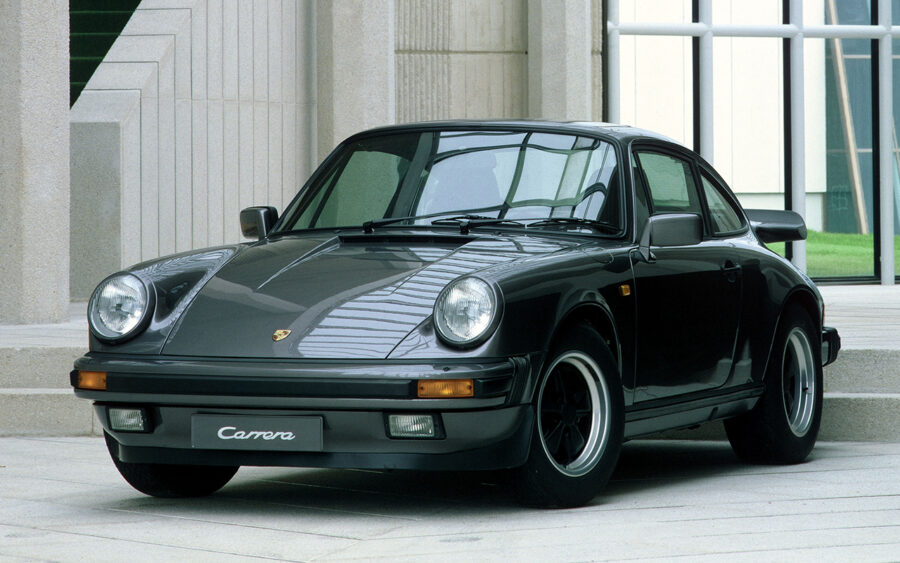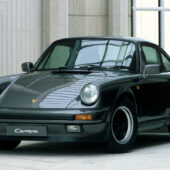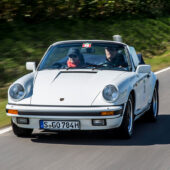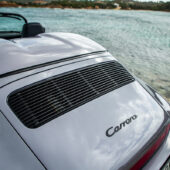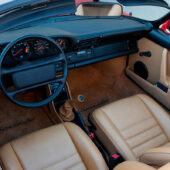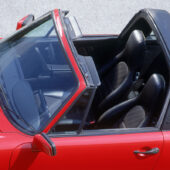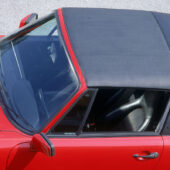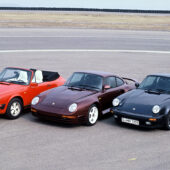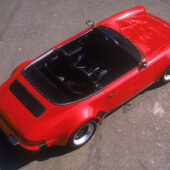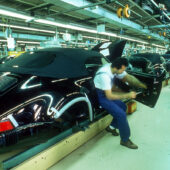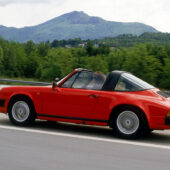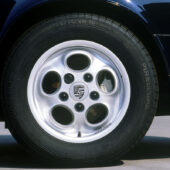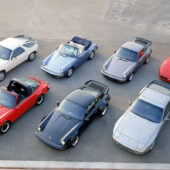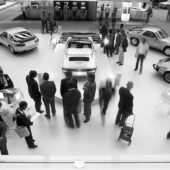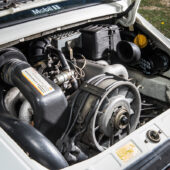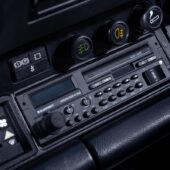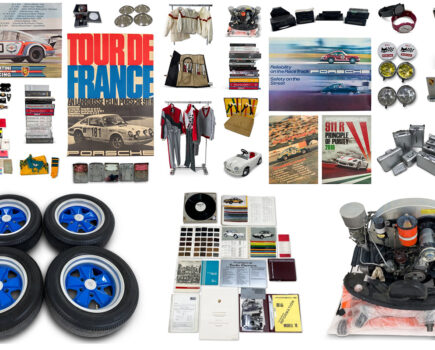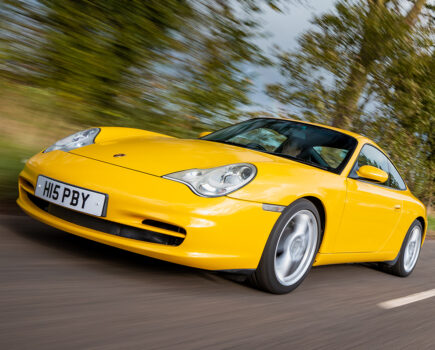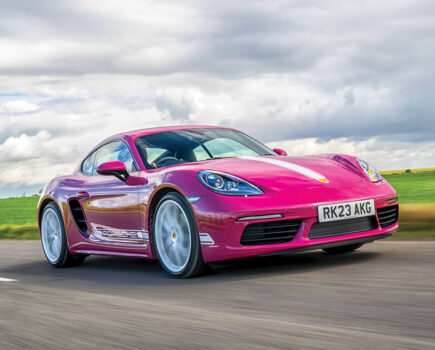The poster car for a generation of sports car fans, the Porsche 911 Carrera 3.2 decorated bedroom and office walls all over the world
Words: Richard Gooding
The classic 911 is Porsche’s ultimate – some would say untouchable – icon. We all know this to be true, but there was a time in the late 1970s when the manufacturer was considering the model’s discontinuation. With square-edged transaxle models ably proving there was life outside the curvy coupé, many saw the 911 and its air-cooled engine as being long in the tooth. Despite these concerns, however, the three-litre 911 SC was released to great acclaim in 1978. Even though the new car was down on power when compared to the Carrera 3.0 it replaced, strong sales forced a rethink in Stuttgart. It seemed there was still life in the 911 concept after all.
Arriving for the 1984 model year, the Carrera 3.2 is regarded by many Porsche enthusiasts and motoring hacks as the greatest incarnation of Porsche’s air-cooled flagship. A big step forward from the SC it superseded, the new and improved 911 was still very much an ‘analogue’ sports car, bereft of driver aids and powered by the traditional air-cooled flat-six. It was, of course, based on the ‘impact bumper’ G-series body introduced a decade earlier, yet the Carrera 3.2’s familiar shape and galvanised body panels clothed a substantial evolution in the 911 story.
The Carrera 3.2 was immediately available in coupé, Targa and Cabriolet variants. It marked the first time the Carrera script had appeared on a 911 since 1977, but the biggest change was hinted at in the new car’s designation: Carrera 3.2 namechecked the 3,164cc flat-six, a unit Porsche claimed to be eighty percent new. The higher displacement was arrived at by using the 95mm bore from the three-litre SC in conjunction with the 3.3-litre 930 Turbo’s 74.4mm crankshaft stroke, along with a compression ratio of 10.3:1. Bosch L-Jetronic fuel injection and Motronic 2 Digital Motor Electronics (DME) encouraged smooth engine running and mechanical reliability, while new inlet and exhaust pipework was also fitted. Power was up to 231bhp, with 209lb-ft torque delivered at 4,800rpm. This was the most powerful normally aspirated 911 to date, managing the nought to 60mph dash in 6.1 seconds and racking up a top speed of 152mph.
The first production 911 to feature an ECU controlling ignition and fuel systems, the Carrera 3.2 achieved 100mph in just 13.6 seconds. At a stroke, with performance nipping at the heels of the original 930, the ‘regular’ 911 had gone from sports car to junior supercar.
Cars destined for the USA, however, were more super car than supercar. A reduced 9.5:1 compression ratio and a smog-stifling catalytic converter dropped power by 24bhp, resulting in 207bhp (still at 5,900rpm), while the sprint to 60mph was extended by 0.2 seconds. The sometimes recalcitrant 915 five-speed manual transmission was fitted to all Carrera 3.2s after working well in the SC, while brakes were enlarged with 286mm front and 294mm rear discs more than capable of bringing the new 911 to a swift halt. Elsewhere, the well-documented cam chain tensioner bugbear was remedied with a new oil-feed system, and a fit-for-purpose finned oil cooler replaced the serpentine lines in the passenger footwell. There was a thermostatically controlled cooling fan for Carrera 3.2s built from 1987, but all this extra kit came at the expense of weight: the Carrera 3.2’s bulk was up 50kg on the 911 SC.
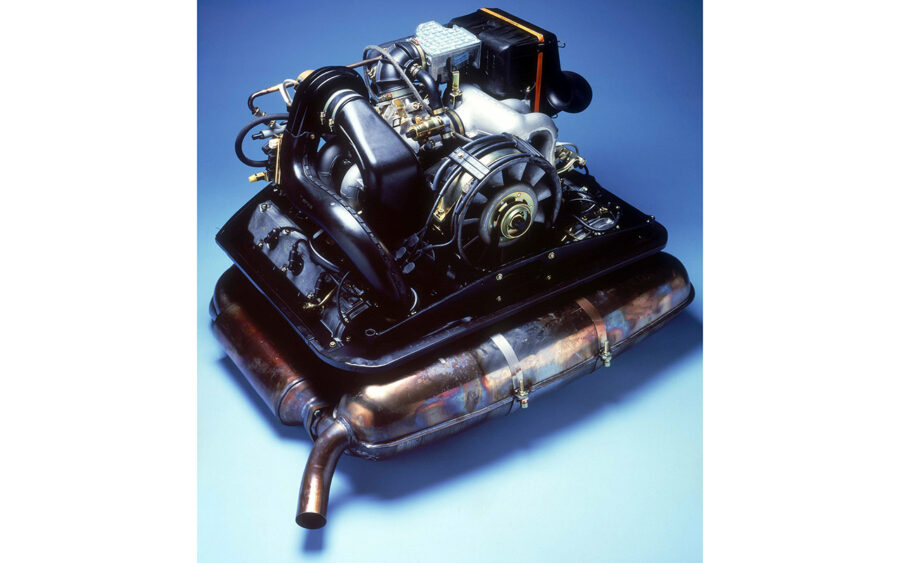
It’s not easy for the layman to tell the difference between the Carrera 3.2 and its SC-badged predecessor, but look closely and the clues are there. The new car wore Teledial wheels — Fuchs five-leaves were offered as an optional extra — while an air dam with integrated fog lamps tidied up the front end. That is, of course, unless you ticked the Turbo Look box when specifying options for your new 911. Officially known as the M491 option and available for an extra DM25,590 through Porsche’s Sonderwunsch (Special Wishes) department, your Carrera 3.2 gained Turbo-aping wide wheel arches, a ‘whale tail’ wing and a wraparound front spoiler. The 930’s stiffer suspension, superior braking system and wider wheels also migrated to Turbo Look Carrera 3.2s, initially only available as an option for the 911 coupe, before being rolled out to Targas and Cabriolets with stronger shells. In 1986, Turbo Look became a regular model — known in the UK for a year as Carrera with Sport Equipment — before being renamed Carrera Supersport a year later.
Due to strict emissions regulations dictating the non-availability of the 930 in the USA from 1984 to 1986, the wide-hipped, big-tailed, Turbo Look Supersport was particularly popular Stateside, becoming an unmistakable 1980s cultural icon. Somewhat muddying the water, the Sport option became 911 with Sport Equipment.
On launch, the Carrera 3.2 coupé was priced at DM68,560, rising to DM71,660 for the Targa. Ironically, as became the norm, less car meant a bigger price, with Porsche asking DM75,980 for the fabric-roofed Cabriolet. And as was always the case with Porsche’s creations, evolution and a programme of subtle lifecycle improvements began without delay. Indeed, only a year after the first Carrera 3.2 appeared, the model gained a shorter gear shift, a radio aerial embedded in the windscreen and slimmer front seats accompanied by the option of electrically controlled adjustment.
For the 1986 model year, all Carrera 3.2s received a redesigned dashboard with larger air-conditioning vents, while the front seats were lowered by 20mm and boasted increased fore and travel. Central locking became standard equipment. Engine management and fuel map changes for North America brought power up to the 217bhp mark, and body shells were guaranteed against rust perforation for ten years. These changes wowed the car buying public, with 1986 becoming the Carrera 3.2’s most popular sales year, demonstrated by the assembly of 14,584 units.
A substantial change came in 1987 with the introduction of the Getrag G50 five-speed gearbox, BorgWarner synchronisers and a hydraulic clutch. Much more helpful in letting the driver get on with the job of, er, driving, the revised transmission was one of the Carrera 3.2’s most celebrated refinements. In a spot of tidying, Porsche also made changes to the car’s rear lights, moving fog lamps into the red reflective fill strip. Electric power roof operation became standard functionality for Cabriolets, while 911s with catalysts were introduced in Europe. Then, in 1988, fifteen-inch Fuchs alloys replaced the standard Teledials — sixteen-inch wheels were still an option — and Porsche added the rather useful passenger door mirror free of charge. A year later, as seen on the 944 Turbo, door lock pins were fitted with flashing red diodes designed to repel opportunist car thieves, while sixteen-inch wheels became standard fit. The famous Flachbau ‘slant nose’ body style was also available to order, although only a handful of UK-bound cars ever received the treatment.

1989 marked the end of the G-series 911, but Porsche continued to develop the Carrera 3.2 until the bitter end. The Speedster variant (option M503) borrows its inspiration, name and style from identically named 356 of the 1950s. Essentially a low-roof version of the Cabriolet, the DM110,000 two-seater featured a cut-down windscreen and a pair of body-coloured polyurethane ‘humps’ covering an unlined, manually-operated hood. Buyers could choose between a narrow-body or ‘Turbo Look’ Speedster, each benefiting from a model-specific front valance. Between January and July 1989, 2,104 Speedsters were built. Only 161 were narrow-bodied, and only 139 were right-hand drive.
One of the most visually arresting 911s ever made, the Carrera 3.2 Speedster idea was first floated in 1983. Yes, it took an astonishing six years to reach production, and even after this long period of gestation, the resulting 911 was very much a ‘fair-weather’ Porsche, so much so main dealers were instructed to make buyers sign a weather damage waiver before each car was permitted to roll out of the showroom. The Anniversary 911 also came in 1989, a limited-volume Carrera 3.2 celebrating twenty-five years of the air-cooled classic. As was the case with the Commemorative 911 produced in 1988 (to celebrate the 250,000th 911), changes were only skin deep: Anniversary 911s were Silver Metallic or Satin Black Metallic and featured body-coloured Fuchs wheels, front and rear spoilers and a plush leather interior accompanied by a special plaque. A total of fifty Anniversary 911s are believed to have been sold in the UK, totalling thirty coupés, the remainder being a split of Targa and Cabriolet models.
Exclusivity had been available from the very beginning, though. Made to celebrate the tenth anniversary of the Carrera RS 2.7, the Carrera ST (Senza Turbo) was limited to just ten cars for the 1984 model year. Solely produced for the Italian market, power was hiked to 255bhp, while Grand Prix White paint was offered with blue or red body graphics and colour-matched Fuchs. An engraved dashboard plaque and a ‘ducktail’ rear spoiler were other special features of this very rare car.
A favourite of the red-braced, champagne-quaffing and Filofax-toting Yuppie, the Carrera 3.2 was one of the most popular 911s, with production volume totalling 74,026 examples (35,571 coupés, 18,468 Targas and 19,987 Cabriolets), each representing the ultimate development of Porsche’s torsion bar suspension concept. As was the case with the 944, though, in response to a barrage of competition from the Far East, the 911 concept needed another shot in the arm. A rebirth of the model came with the end of the G-series line and the arrival of the 964 in 1989. More usable and more refined, the new 911 featured vastly updated body styling and new braking and suspension technology delivering superior performance and handling. Not one to shy away from percentage-based marketing snippets, Porsche claimed the 964 to be eighty-seven percent new when compared with the outgoing Carrera 3.2.
Many saw the 964 as a move away from the reputation of high-powered 911s as ‘widow makers’, but this label is unfair when discussing the Carrera 3.2. Only under serious provocation will the car’s rear end pendulum effect come into play — surefootedness is encouraged by an impressive 42/58 percent front-rear balance. What is deserved is the Carrera 3.2’s standing as a model cementing the 911’s reputation for quality of build and reliability. Today, this fantastic air-cooled 911 offers lucky owners performance and panache with few drawbacks, but prices have risen sharply in recent years. If you want the best in naturally aspirated 911 from the 1980s, then act fast, else you might just find yourself staring at the poster on your bedroom wall for far longer than you imagined!

Porsche 911 3.2 Carrera timeline
1984
911 3.2 Carrera arrives in coupé, Targa and Cabriolet guises as replacement for the 911 SC originally introduced in 1978.
Carrera ST model introduced for Italy only in ten-car limited run
1986
All Carrera 3.2 models get a redesigned dashboard, standard central locking, plus engine management and fuel map changes for America
3.2 Carrera posts its most popular sales year with 14,584 sold
1987
G50 five-speed gearbox, BorgWarner synchronisers and a hydraulic clutch added. Catalytic converters introduced on European models
Mild styling change with fog lamps integrated into the red reflective fill strip. Electric power roof now standard on Cabriolet model

1988
Fuchs alloys replace standard Teledial wheels; passenger-side mirror added as standard
1989
Door-lock pins were fitted with flashing red diodes as per Porsche 944 Turbo. 16-inch wheels now standard fit
Flachbau ‘slant nose’ bodystyle available. Small number of UK cars specified as such
911 Speedster variant – a low-roof version of the Cabriolet – introduced in narrow-body or ‘Turbo Look’ bodystyles with 2,104 built. Just 139 right-hand-drive examples made
G-series 911 production ends; 964-generation 911 introduced as its replacement

